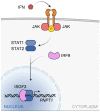Activity and Function in Human Cells of the Evolutionary Conserved Exonuclease Polynucleotide Phosphorylase
- PMID: 35163574
- PMCID: PMC8836086
- DOI: 10.3390/ijms23031652
Activity and Function in Human Cells of the Evolutionary Conserved Exonuclease Polynucleotide Phosphorylase
Abstract
Polynucleotide phosphorylase (PNPase) is a phosphorolytic RNA exonuclease highly conserved throughout evolution. Human PNPase (hPNPase) is located in mitochondria and is essential for mitochondrial function and homeostasis. Not surprisingly, mutations in the PNPT1 gene, encoding hPNPase, cause serious diseases. hPNPase has been implicated in a plethora of processes taking place in different cell compartments and involving other proteins, some of which physically interact with hPNPase. This paper reviews hPNPase RNA binding and catalytic activity in relation with the protein structure and in comparison, with the activity of bacterial PNPases. The functions ascribed to hPNPase in different cell compartments are discussed, highlighting the gaps that still need to be filled to understand the physiological role of this ancient protein in human cells.
Keywords: PNPT1; PNPase; RNA binding protein; RNA decay; RNA degradosome; RNA stability; exoribonuclease; mitochondrial RNA; polyribonucleotide phosphorylase.
Conflict of interest statement
The authors declare no conflict of interest.
Figures



Similar articles
-
Structural insights into human PNPase in health and disease.Nucleic Acids Res. 2025 Feb 8;53(4):gkaf119. doi: 10.1093/nar/gkaf119. Nucleic Acids Res. 2025. PMID: 39997218 Free PMC article.
-
Polynucleotide phosphorylase: an evolutionary conserved gene with an expanding repertoire of functions.Pharmacol Ther. 2006 Oct;112(1):243-63. doi: 10.1016/j.pharmthera.2006.04.003. Epub 2006 Jun 2. Pharmacol Ther. 2006. PMID: 16733069 Review.
-
Crystal structure of human polynucleotide phosphorylase: insights into its domain function in RNA binding and degradation.Nucleic Acids Res. 2012 May;40(9):4146-57. doi: 10.1093/nar/gkr1281. Epub 2011 Dec 30. Nucleic Acids Res. 2012. PMID: 22210891 Free PMC article.
-
Expression regulation and genomic organization of human polynucleotide phosphorylase, hPNPase(old-35), a Type I interferon inducible early response gene.Gene. 2003 Oct 16;316:143-56. doi: 10.1016/s0378-1119(03)00752-2. Gene. 2003. PMID: 14563561
-
Human polynucleotide phosphorylase (hPNPase(old-35)): an evolutionary conserved gene with an expanding repertoire of RNA degradation functions.Oncogene. 2011 Apr 14;30(15):1733-43. doi: 10.1038/onc.2010.572. Epub 2010 Dec 13. Oncogene. 2011. PMID: 21151174 Free PMC article. Review.
Cited by
-
Human PNPase causes RNA stabilization and accumulation of R-loops in the Escherichia coli model system.Sci Rep. 2023 Jul 21;13(1):11771. doi: 10.1038/s41598-023-38924-x. Sci Rep. 2023. PMID: 37479726 Free PMC article.
-
Advancements in multi-omics research to address challenges in Alzheimer's disease: a systems biology approach utilizing molecular biomarkers and innovative strategies.Front Aging Neurosci. 2025 Jul 23;17:1591796. doi: 10.3389/fnagi.2025.1591796. eCollection 2025. Front Aging Neurosci. 2025. PMID: 40771197 Free PMC article. Review.
-
Research Progress in RNA-Binding Proteins.Int J Mol Sci. 2022 Dec 21;24(1):58. doi: 10.3390/ijms24010058. Int J Mol Sci. 2022. PMID: 36613501 Free PMC article.
-
Structural insights into human PNPase in health and disease.Nucleic Acids Res. 2025 Feb 8;53(4):gkaf119. doi: 10.1093/nar/gkaf119. Nucleic Acids Res. 2025. PMID: 39997218 Free PMC article.
-
How RNases Shape Mitochondrial Transcriptomes.Int J Mol Sci. 2022 May 30;23(11):6141. doi: 10.3390/ijms23116141. Int J Mol Sci. 2022. PMID: 35682820 Free PMC article. Review.

